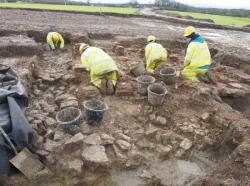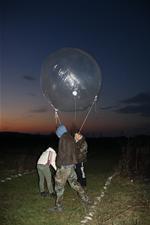INSTITUT SUPERIEUR D'ANTHROPOLOGIE
INSTITUTE OF ANTHROPOLOGY
ONLINE COURSES / COURS A DISTANCE
SPRING TERM : APRIL 2015
REGISTER NOW
ROYAUME UNI –  Aiskew – Workon a new bypass has revealed a Roman villa dating back to the third or fourth century AD which has lain hidden under farmers fields for hundreds of years. Archaeologists say it is a significant find , and the first Roman villa to be discovered in North Yorkshire since the Second World War. It lies near Aiskew, Bedale, close to the A1 which is along the line of Dere Street, the original Roman road from Eboracum the capital of the north at York and the Roman fort of Cataractonium, now modern day Catterick. The villa is described as extensive with a series of rooms and one pavilion type room with under floor heating. There are small sections of mosaics, and evidence of plaster and concrete from floors and walls. Development archaeologist Lucie Hawkins said:”The rooms would have been painted in bright vibrant colours, it is a higher status building and would have had lots of colour. “It is quite a substantial size and was set within a landscaped environment and field systems. "It helps us to look at the wider Roman world , the villa is quite close to the A1 which was a Roman road so we can build up a picture. We can’t say at the moment if it would have been connected to Cataractonium, there are other Roman settlements such as Aldborough.”
Aiskew – Workon a new bypass has revealed a Roman villa dating back to the third or fourth century AD which has lain hidden under farmers fields for hundreds of years. Archaeologists say it is a significant find , and the first Roman villa to be discovered in North Yorkshire since the Second World War. It lies near Aiskew, Bedale, close to the A1 which is along the line of Dere Street, the original Roman road from Eboracum the capital of the north at York and the Roman fort of Cataractonium, now modern day Catterick. The villa is described as extensive with a series of rooms and one pavilion type room with under floor heating. There are small sections of mosaics, and evidence of plaster and concrete from floors and walls. Development archaeologist Lucie Hawkins said:”The rooms would have been painted in bright vibrant colours, it is a higher status building and would have had lots of colour. “It is quite a substantial size and was set within a landscaped environment and field systems. "It helps us to look at the wider Roman world , the villa is quite close to the A1 which was a Roman road so we can build up a picture. We can’t say at the moment if it would have been connected to Cataractonium, there are other Roman settlements such as Aldborough.”
http://www.thenorthernecho.co.uk/news/11871795.Roman_villa_discovered_on_site_of_new_by_pass/
ROYAUME UNI –  Hampton Court Palace -When a palace is 500 years old, and has undergone endless modernisations and remodelling, it's unsurprising that new work can lead to new discoveries. However, a request to repair the uneven floors of a room used by the Royal School of Needlework didn't immediately suggest that exciting finds would follow. When the floorboards were lifted, an extraordinary assortment of brickwork was revealed. It became apparent that the Victorians had simply added supports and laid the floor over the foundations of some much older buildings. In fact, like much of the Palace's Fountain Court, this room covered the site of the former private apartment of the Queen. Which queen? Well, the answer varies with the brickwork colour! The red brick indicates the walls of a new apartment built for Anne Boleyn in the 1530s. Unfortunately, the work lasted longer than Anne's reign. After her execution and Henry VIII's third marriage to Jane Seymour, the rooms were completed - with alterations - for his new Queen around 1537. Among the additions to the original design were bay windows, and we can see the foundations of one of these in the lines of paler bricks. This room was probably the Privy Wardrobe, close to the kitchen and a nursery for Henry VIII's only son Prince Edward.
Hampton Court Palace -When a palace is 500 years old, and has undergone endless modernisations and remodelling, it's unsurprising that new work can lead to new discoveries. However, a request to repair the uneven floors of a room used by the Royal School of Needlework didn't immediately suggest that exciting finds would follow. When the floorboards were lifted, an extraordinary assortment of brickwork was revealed. It became apparent that the Victorians had simply added supports and laid the floor over the foundations of some much older buildings. In fact, like much of the Palace's Fountain Court, this room covered the site of the former private apartment of the Queen. Which queen? Well, the answer varies with the brickwork colour! The red brick indicates the walls of a new apartment built for Anne Boleyn in the 1530s. Unfortunately, the work lasted longer than Anne's reign. After her execution and Henry VIII's third marriage to Jane Seymour, the rooms were completed - with alterations - for his new Queen around 1537. Among the additions to the original design were bay windows, and we can see the foundations of one of these in the lines of paler bricks. This room was probably the Privy Wardrobe, close to the kitchen and a nursery for Henry VIII's only son Prince Edward.
http://carolineld.blogspot.co.uk/2015/03/archaeological-find-at-hampton-court.html
ROUMANIE –  Tibiscum -Researchers from the Institute of Archaeology at the University of Warsaw are studying the infrastructure of the Roman fort Tibiscum in western Romania. Until now, the area around the ancient fortress has not been subject to extensive archaeological reconnaissance. In the field, Polish archaeologists use an arsenal of modern non-invasive methods, which allow to determine what is under the ground without excavations. The first step was surface survey, consisting of methodical search of the area for objects on the surface. Scientists meticulously collect discovered artefacts, mark them with GPS recorders and then put them in a computer GIS database (spatial information system). Among the most interesting monuments found during the examination of the surface is a bracelet from the Bronze Age, preceding the existence of the Roman fort by several millennia. Research depends on the weather. Fortunately, in the last days the weather was favourable. The team has just started air infrared experiments with the use of a helium balloon. Archaeologists will also use drones that will take aerial photographs. At the same time, Polish archaeologists carry out topographical surveys at the nearby fort Cornutel, which probably served as a watchtower on the road leading to Tibiscum. More information on the research is available on the official project fanpage at:www.facebook.com/tibiscumproject
Tibiscum -Researchers from the Institute of Archaeology at the University of Warsaw are studying the infrastructure of the Roman fort Tibiscum in western Romania. Until now, the area around the ancient fortress has not been subject to extensive archaeological reconnaissance. In the field, Polish archaeologists use an arsenal of modern non-invasive methods, which allow to determine what is under the ground without excavations. The first step was surface survey, consisting of methodical search of the area for objects on the surface. Scientists meticulously collect discovered artefacts, mark them with GPS recorders and then put them in a computer GIS database (spatial information system). Among the most interesting monuments found during the examination of the surface is a bracelet from the Bronze Age, preceding the existence of the Roman fort by several millennia. Research depends on the weather. Fortunately, in the last days the weather was favourable. The team has just started air infrared experiments with the use of a helium balloon. Archaeologists will also use drones that will take aerial photographs. At the same time, Polish archaeologists carry out topographical surveys at the nearby fort Cornutel, which probably served as a watchtower on the road leading to Tibiscum. More information on the research is available on the official project fanpage at:www.facebook.com/tibiscumproject
http://scienceinpoland.pap.pl/en/news/news,404239,polish-archaeologists-working-in-romania.html
ESPAGNE –  Altamira - The cave paintings of the Altamira caves in the northern Spain region Cantabria, one of the most important in the world and recognized as World Heritage, will be put at risk by the reopening of them to the public. El Pais on Thursday reported that the Pre-History Department of Madrid's Complutense University had sent a letter to the United Nations Educational, Scientific and Cultural Organization (UNESCO) criticizing the cave management and saying that ''the new program of the Spanish culture ministry, a plan that entails the opening of the cave to visitors, raises important questions about conservation and puts fragile heritage that is enormously important for the understanding of Paleolithic society at risk.
Altamira - The cave paintings of the Altamira caves in the northern Spain region Cantabria, one of the most important in the world and recognized as World Heritage, will be put at risk by the reopening of them to the public. El Pais on Thursday reported that the Pre-History Department of Madrid's Complutense University had sent a letter to the United Nations Educational, Scientific and Cultural Organization (UNESCO) criticizing the cave management and saying that ''the new program of the Spanish culture ministry, a plan that entails the opening of the cave to visitors, raises important questions about conservation and puts fragile heritage that is enormously important for the understanding of Paleolithic society at risk.
http://www.ansamed.info/ansamed/en/news/sections/culture/2015/03/19/spain-experts-criticize-altamira-cave-reopening-to-public_b49b1a46-5a7d-4f11-927d-992194d3956f.html